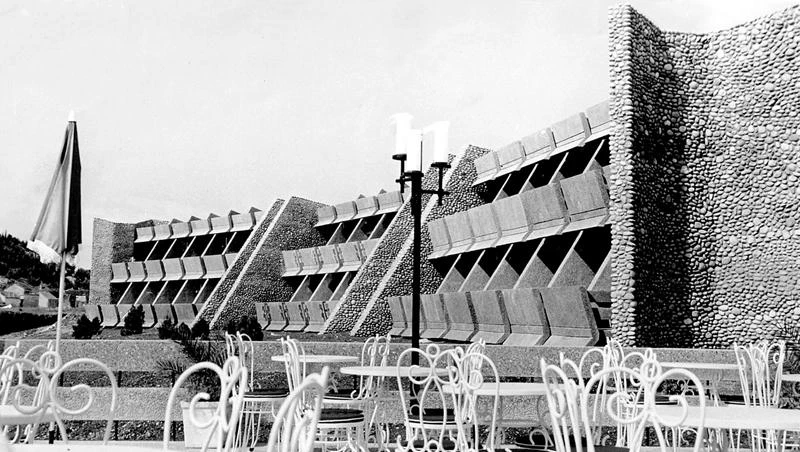
‘Skirting the Center: Svetlana Kana Radević on the Periphery of Postwar Architecture’, an exhibition at the Venice Biennale, Palazzo Palumbo Fossati, May 22–November 21, 2021. Svetlana Kana Radević’s architecture adapted modernism to the peculiarities of history and politics in Communist Yugoslavia.
The Memorial to the Fallen of the Lješanska Nahija Region, designed by Svetlana Kana Radević, stands on a small hill in Barutana, Montenegro. Concrete tendrils rise into the air, stained by time and weather; they might signify a torch, or a flower, or hands stretched upward. On one side of the torch-flower are evenly spaced concrete stools. They look like the petrified stumps of trees—mute spectators. The central monument, which sits at the top of the hill, is approached via three smaller circular alcoves containing groves of concrete stems, like plants that have been cut with a sharp blade. In aerial photos and in Radević’s beautifully rendered plans for the complex, the network of rings looks like a diagram of a molecule.
The “fallen” being commemorated are the Yugoslavs killed in the First Balkan War (1912–1913)—Montenegro was the first of the Balkan League nations to declare war against the Ottomans—and in the two world wars. Yugoslavia had some of the highest national casualties per capita during World War II, which brought not only its occupation by Axis powers and resistance by Communist partisans and other factions, but also a conflict among Serbs, Croats, and Slovenes. The Communist partisan fighters were unique in their belief that ideology trumped ethnic or national identity. When the Communists emerged victorious at the end of the war, they faced the task of restoring the fragile harmony of the South Slavs—Serbs, Croats, Slovenes, Bosniaks, Macedonians, and Montenegrins—that had been established in 1918 by the formation of the Kingdom of Yugoslavia and then shattered by the war.
Architecture, monuments, and infrastructure served to stimulate interregional travel and establish a shared public memory. They were important parts of Yugoslavia’s effort to establish a federation that allowed for the peaceful coexistence of its citizens. The state encouraged domestic tourism and communal leisure as ways of building patriotism and bringing about “friendship of the peoples” (to borrow a Soviet term) through shared vacations. Every Yugoslav worker had the right to two weeks of paid holiday every year, while the government launched an educational campaign celebrating the virtues of holidays spent away from home...
The New York Review: Designs for Living


